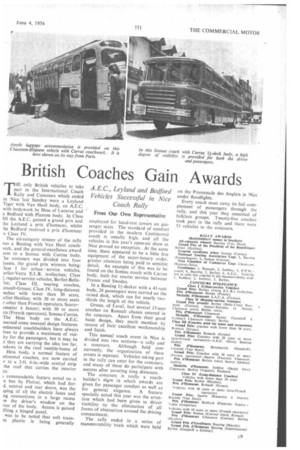British Coaches Gain Awards
Page 47

If you've noticed an error in this article please click here to report it so we can fix it.
A.E.C., Leyland and Bedford Vehicles Successful in Nice Coach Rally
From Our. Own Representative THE only British vehicles to take part in the International Coach Rally and Concours which ended in Nice last Sunday were a Leyland Tiger with Van Hool body, an A.E.C. with bodywork by Hess of Lucerne and a Bedford with Plaxton body. In Class Ill the A.E.C. gained a grand prix and he Leyland a prix d'honneur, whilst he Bedford received a prix d'honneur n Class IV.
The all-category winner of the rally vas a Bussing with Van Hoot coachvork, and the general-excellence award tent to a Somua with Currus body. he concours was divided into four lasses, the grand prix winners being: lass 1 for urban service vehicles, erliet-Vetra E.L.R. trolleybus; Class I, regular-service vehicles, Berliet-Bellelot; Class III, touring coaches, enault-Gruau; Class IV, long-distance >aches with fewer than 30 seats, ;:rliet-Heuliez; with 30 or more seats r other than French operators, Saurertmseier a hazer; with 30 or more its (French operators), Somua-Currus. The Hess body on the A.E.C. ssessed some unusual design features. intinental coachbuilders have always iven to provide a maximum of visiity for the passengers, but it may be it they are carrying the idea too far. ndows in the roof tumble-home of Hess body, a normal feature of ntinental coaches, are now carried ir to a 2-ft. 6-in.-wide central strip the roof that carries the interior its.
■ commendable feature noted on a in bus by Floirat, which had ford, central and rear doors, was the iping of all the electric fuses and ng connections in a large recess iw the driver's window on the nor of the body. Access is gained Ming a hinged panel.
was to be noted that soft transnt plastic is being generally employed for head-rest covers on passenger seats. The standard of comfort provided in the modern Continental coach is usually high, and all the vehicles in this year's open-air show at Nice proved no exception. At the same time, there appeared to be a little less equipment of the super-luxury order, greater attention being paid to sensible detail. An example of this was to be found on the Somua coach with Currus body, built for tourist service between France and Sweden.
In a Bussing lii-decker with a 41-seat body, 26 passengers were carried on the raised deck, which ran for nearly twothirds the length of the vehicle.
Gruau, of Laval, had several 15-seat coaches on ftenault chassis entered in the concours. Apart from their good basic design, they merit mention by reason of their excellent workmanship and finish.
This annual coach event in Nice is divided into two sections—a rally and a concours. Although held concurrently, the organization of these events is separate. Vehicles taking part in the rally can enter for the concours, and many of them do participate with success after covering long distances.
The concours is really a coachbuilder's shpw in which awards are given for passenger comfort as well as for general elegance. A feature specially noted this year was the attention which had been given to driver visibility by the elimination of all forms of obstruction around the driving compartment.
The rally ended in a series of manceuvrability trials which were held on the Promenade des Anglais in Nice under floodlights.
Every coach must carry its full complement of passengers through the rally, and this year they consisted of folklore groups. Twenty-five coaches took part in the rally and there were 53 vehicles in the concours.












































































































